Almería
Andalusia, SpainThe port of Almería is a major starting point for trips to North Africa. The beautiful Andalusian city is distinguished for its multicultural tradition and grand medieval history. On Ferryhopper, you can explore all ferry routes and plan the ferry crossing across the Alboran Sea with cheap ferry tickets.
Find useful information about the ferry port of Almería and read about your holidays in the city:
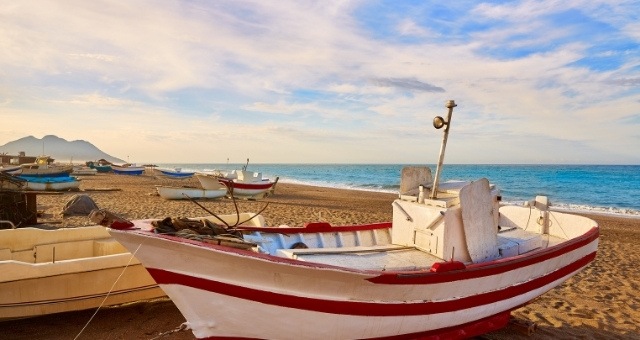
Fishing boats at Cabo de Gata in Almería
Almería ferry port
The port of Almería is a busy transport hub both for passengers traveling to North Africa, as well as cargo ships. The modern port has been in development since the 19th century, but Almería has been an important maritime stop since Medieval times.
The port is well integrated with the city of Almería. It is also close to interesting attractions, restaurants, cafes, shops, and supermarkets. You can easily walk from the city center to the ferry terminal building.
The passenger terminal building is located on the east side of the port area. Passengers traveling to Morocco, Algeria and Melilla can access the terminal building 24/7.
The ferry companies currently operating at Almería port are Baleària, Naviera Armas and Trasmediterránea.
The port has a large, shaded parking area for passengers boarding the ferry with their vehicles. There’s also an open-air public car park at the Muelle de Levante dock with direct access to the port area. The public car park is both for short-term and long-term stays.
As for traveler services, there are duty-free shops, ticket kiosks, tourist information points, cash machines, cafes, toilets, and Wi-Fi in the main building.
Ferries from Almería port: schedules and tickets
From the port of Almería, you can normally catch a ferry to Melilla, as well as the Moroccan city of Nador in North Africa. There are also ferry crossings to Ghazaouet and Oran in Algeria.
See more information below about the ferry routes from Almería port to the African peninsula:
- Almería - Nador ferry: the Almería - Nador ferry route runs up to 5 daily crossings all year long. The duration of the trip to Nador ranges from about 8 to 9 hours.
- Almería - Melilla ferry: there are several weekly crossings operating the Almería - Melilla ferry route. The ferry trip lasts 7-8 hours and standard tickets from the Andalusian port to Melilla start at around €70.
- Almería - Ghazaouet ferry: the Almería - Ghazaouet ferry route is available 1-3 days per week with a crossing duration of around 8-9 hours.
- Almería - Oran ferry: there is usually 1 weekly ferry crossing from Almería to Oran in Algeria, taking about 8 hours.
Where is the ferry port in Almería?
Almería is on the southeastern coast of Spain in the region of Andalusia. The port of Almería is perfectly situated in the city center right below Parque Nicolás Salmerón.
How to get to Almería port?
You can reach the port of Almería on foot, by car or bus. It's just a 15-minute walk from most downtown hotels and the central market.
If you’re driving to the port, you can follow motorway A7 and take exit 438. As for taxis, you can hail one in the street or get one from the major points of interest around the city.
As for the public transport, there are plenty of buses passing by the port, including bus routes 1 and 6. Also, the train station is only a 10-minute walk from the port and the airport is 20 minutes away by car.
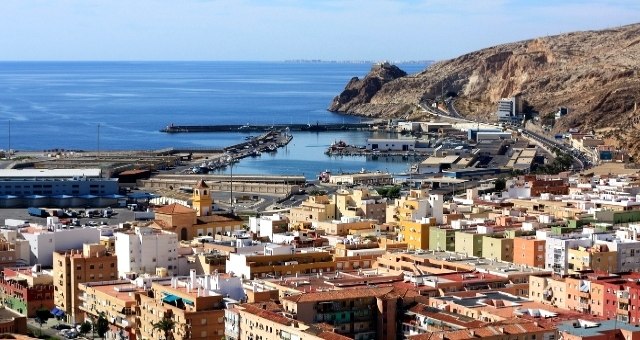
The vibrant city and port of Almería as seen from the Alcazaba
Vacation in Almería
Almería is a lively city with much to see and do all year round. The port city is extra popular during the summer months both because of its amazing beaches and sunny weather, as well as its port connections to North Africa.
Many travelers choose to spend 2-3 days in Almería before taking the ferry to North Africa or stay for the entire summer to explore the whole region with its many hidden gems. The coast of Almería as well as the majestic inland are two of the most unexplored regions in Andalusia!
From natural parks and hiking trails to intense nightlife and secluded beaches, Almería is a great choice for a city break or nature-oriented holidays.
Good to know: there are many expats from the UK and more countries buying property in Almería. The city attracts international visitors because of its high-end services, relaxed vibe and clear blue sky.
How to get to Almería
You can get to Almería by plane, bus, train, and ferry. If you’re visiting Almería from elsewhere in Spain, you can reach the city with your own vehicle too.
The airport of Almería, situated 9 km from downtown Almería, serves flights from major Spanish cities as well as international destinations.
As for land transport, there are buses and trains arriving at Almería’s Intermodal station year-round. You can get a train or bus to Almería from major cities and towns in Spain. Trains are normally operated by Renfe and buses by Alsa.
As for ferry routes, you can currently get to Almería from Melilla, Nador, Ghazaouet, and Oran.
Tip: the airport of Almería is connected with the city center by bus route 30. The ticket price is around €1 and the ride lasts around 35 minutes.
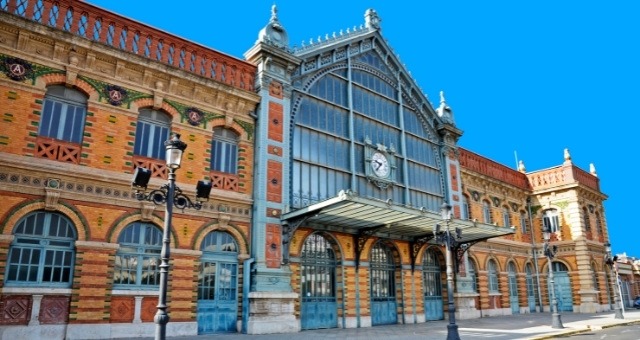
The impressive old train station of Almería
What to do in Almería
Almería is a fabulous tourist destination in the south of Spain with a rich history and cultural production. It perfectly combines tradition with cosmopolitanism and it is popular both with locals and international travelers.
You should not miss out on the Museum and the Cathedral of Almería, as well as the Guitar Museum, dedicated to the work of the great guitarist Antonio de Torres Jurado. As for outdoor activities, we recommend hiking in the Cabo de Gata-Níjar Natural Park and trekking in the Tabernas desert.
Almería is also one of the sunniest cities in Europe, which makes it ideal for activities like hiking, horseback riding, sailing or a picnic in the countryside. Moreover, the region of Almería is an oasis of unspoiled beaches for every taste! Impressive rocks, golden coasts, family-friendly beaches, and nude-friendly coves are waiting for you.
Tip: Almería normally experiences dry, short winters with temperatures rarely falling under 10°C. It does get windy in the winter months, but you can still enjoy your time in nature.
Beaches in Almería
Discover the allure of Almería, home to some of Spain's most enchanting beaches. Renowned for their pristine and unspoiled beauty, these beaches are categorized into 4 geographical areas from east to west: Levante, Cabo de Gata, Almería Bay, and Poniente.
The year-long sun and the variety of landscapes make Almería a hot destination when it comes to holidays at the beach. There are secluded coves for peace and relaxation, busy coasts with visitor amenities, as well as remote sandy stretches perfect for a blissful escape from city life.
Here are our 10 favorite beaches in Almería:
- Playa de los Muertos: located in the Cabo de Gata-Nijar Natural Park, this is a long coast with small pebbles and sand. It has amazing blue waters and few wind-protected spots. You can access the beach via a hiking trail.
- Playa de Mónsul: this dark-sand beach is one of the most popular in Cabo de Gata. Thin sand, lava rocks and a distinctive rock in the middle of the beach create an amazing scenery! It has crystal-clear waters and a small parking lot. There are no visitor amenities in Playa de Mónsul.
- Playa de los Genoveses: this is an untamed 1 km-long beach with sand dunes and an easy-going atmosphere. It has shallow clear waters and cacti fields. The best way to get there is on foot or by bike from San José.
- Playazo de Rodalquilar: this picturesque beach is one of the best in Almería. It has golden sand, calm waters and fossilized dunes! The amazing San Ramón Castle is also on the beach.
- Playa del Zapillo: this is one of the city beaches of Almería. It is a sandy coast with sun loungers and umbrellas, great for families. It is also within walking distance to many restaurants, shops and cafes.
- Playa de las Amoladeras: the long sandy beach is in Cabo de Gata, 30 minutes from Almería by car. It is covered with dark sand and pebbles, and it often gets windy. You can see the Roman remains of a fish factory on the west side of the beach. Access to this remote beach is quite tricky by car.
- Playa de Aguadulce: it’s a long sandy beach west of Almería. It is close to several cafes, shops and restaurants, and you can find sun loungers and umbrellas.
- Playa de las Negras: the beach of Las Negras town is a pebble beach close to visitor amenities. Access to the beach is easy for people with reduced mobility. You can go scuba diving at Las Negras, as the waters are clear.
- Cala de Enmedio: Cala de Enmedio may not be that close to Almería, but it’s definitely worth a visit! This unique rocky beach has crystal-clear waters and fine sand. It is distinguished by its lunar-like gray cliffs.
- Playa de las Salinas: this is a beautiful, sandy beach in the town of Roquetas de Mar. The lakes above the beach are perfect for bird-watching. There are no visitor amenities.
Good to know: many of the beaches in Cabo de Gata are popular for clothing-optional swimming and sunbathing!
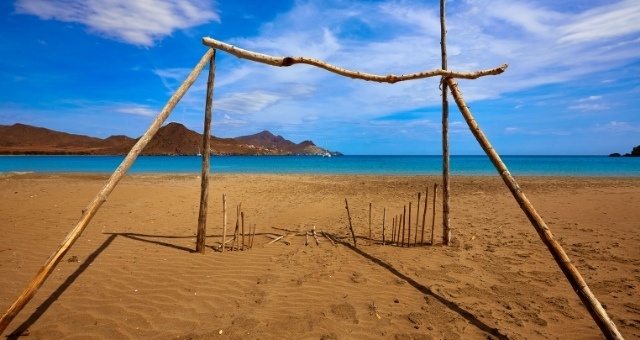
The sandy Playa de los Genoveses in Almería
Sightseeing and activities in Almería
In Almería, you can have fun exploring the countryside, visiting the city’s interesting museums or trying outdoor activities in nature. From war monuments to an impressive desert (!), the region attracts history buffs and nature enthusiasts alike!
Here are some of the best attractions and activities in Almería:
- Explore the Cabo de Gata-Níjar Natural Park
- Try trekking in the Tabernas desert, Europe’s only desert some 30 km northwest of Almería
- Discover the spectacular Alcazaba of Almería, a Moorish palace founded in the mid-10th century
- Visit the formidable Catedral de la Encarnación
- Go village-hopping at the Sierra de Los Filabres mountain range
- Walk around the picturesque Pescadería - La Chanca neighborhood
- Conquer mountain Mulhacén in Sierra Nevada, the highest mountain in mainland Spain
- Learn about Almería’s air raid shelters
- Discover the music tradition of Almería at the Guitar Museum
- Marvel at the archaeological findings at the Museo de Arqueólogico de Almeria
- Go on a day trip to the region of Valle del Almanzora
Fun fact: Depeche Mode filmed their music video for “Personal Jesus” in the Tabernas Desert in Almería!

The 10th century Alcazaba fortification in Almería
Nightlife in Almería
Almería is one of the best party places in Andalusia! There are beautiful terrace bars for tapas and drinks in the city center (also known as the Cuatro Calles neighborhood), as well as restaurants and beach bars along the city coast.
Apart from the old town and the beach, many locals choose Plaza Masnou for their night fun. There are many casual bars hidden in the paved alleys of the neighborhood.
As for dancing, Almería’s clubs do not disappoint! Particularly during the summer months, there are many venues, where you dance all night long. Bear in mind real fun starts at 02:00 in Almería!
Food in Almería
Simple ingredients, age-old recipes and a real love for food distinguish Almería’s cuisine. At the beachfront fish restaurants, fantastic city center tapas bars and fine-dining restaurants around the region, you will taste delicious dishes.
The local gastronomy is influenced at large by the Andalusian tradition, as well as the Mediterranean climate. At the same time, Arab flavors and techniques have also enriched the Almería food scene.
Here’s what you need to try in Almería:
- patatas en ajopollo (potatoes with a garlic, bread and almond paste)
- potaje de vigilia (bean and cod soup)
- gurullos con conejo (rice and rabbit stew with saffron)
- bouillabaisse (fish stew usually prepared with monkfish or clams)
- plato alpujarreño (dish with potatoes, ham, sausages, and fried eggs)
- chérigan (slice of bread topped with aioli sauce and diverse toppings)
- ajo colorao (cod served with a rich tomato, peppers and potato purée)
- papaviejos (deep-fried, sugar-coated donuts)
Villages in Almería
The province of Almería combines sea and mountain locations with distinct characteristics. You can visit beach resorts, whitewashed mountain villages with intact local character and bustling towns.
Here are the 7 best places for day trips around Almería:
- Olula de Castro: the prehistoric village situated in the sunny part of the Sierra de los Filabres is made up of white houses with slate roofs. While strolling between olive and almond trees, you can visit the Calar Alto Observatory, the largest astronomical observatory on the European continent.
- Albánchez: it is a mountainous village with whitewashed houses located in the northern foothills of the Sierra de los Filabres. Among its highlights are the impressive Roman Aqueduct of Albánchez and the stunning Los Caños fountain.
- Castro de Filabres: it is situated on the southern slope of the Sierra de Filabres in a rustic landscape. The almond trees dominate the area and almonds are the main ingredient for most local delicacies and sweets.
- Macael: famous for its marble quarries, the village of Macael is a marvel to explore. The imposing Parish Church located in the central square of the village is a great place to start your walking tour.
- San José: it's a village and fishing port in the center of Parque Natural de Cabo de Gata-Níjar with charming beaches.
- Las Negras: the village takes its name from the black mountain and the cliffs located to the north of the village. It's a large mass of dark volcanic material, dominating the shoreline with its dark color.
- Roquetas de Mar: the town of Roquetas de Mar is situated in southern Spain. It’s known for the mesmerizing beaches of Serena and La Bajadilla. Also, it has an amazing Aquarium offering activities like shark diving.
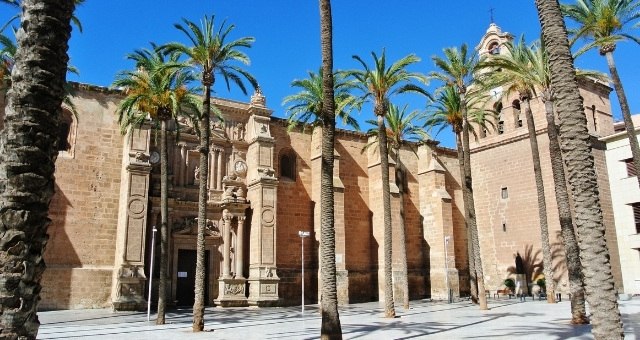
The serene courtyard in front of the iconic cathedral of Almería
Useful information about Almería
Almería is an energetic port city combining modern and traditional elements. There are quaint neighborhoods, as well as modern spots. The city is lively throughout the year and there are plenty of visitor amenities for your holidays in the city or your trip to catch the ferry.
In Almería, you can stay at luxury hotels, budget-friendly hostels with an easy-going vibe or vacation rentals for longer stays. Most of the hotel options are in the historic city center and the Nueva Almería neighborhood. If you want to be closer to Cabo de Gata, you can also stay at the amazing Camping Los Escullos or the campsite of your choice in the area.
As for medical services, there are well-equipped hospitals such as the Torrecárdenas University Hospital and the Hospital HLA Mediterráneo. You can also find smaller clinics and pharmacies all around the city.
Tip: remember to have up-to-date health insurance or get your European Health Insurance Card in advance.
Important phone numbers for your stay in Almería
Here’s some useful contact information for your trip to Almería:
- Almería Port Police: +34950236820
- Almería Port Authority: +34950236033
- Torrecárdenas University Hospital: +34950016000
- Almería airport: +34913211000
- Intermodal train and bus station: +34950173602
- Almería taxi services: +34950222222
- European emergency number: 112
Transportation in Almería
To get around Almería you can walk, use the bus or ride a taxi. Almería is a small city with a bustling city center, where you will find anything you need. There are many hotels, museums, shops, and visitor services, which are accessible on foot.
As for public transportation, buses in Almería are frequent and reliable. There are plenty of bus stops around the city served by 16 bus routes. Buses cover most of the city, transferring passengers from the port area all the way to Torrecárdenas University Hospital in the north, as well as to the airport of Almería on the east coast.
There are also taxis in designated areas in the city center. You can also hail taxis or call a radio taxi to pick you up.
Good to know: for trips to the suburbs or Almería, as well as neighboring towns and villages, you can get a bus or train from the Intermodal Station of Almería at Plaza de la Estación.
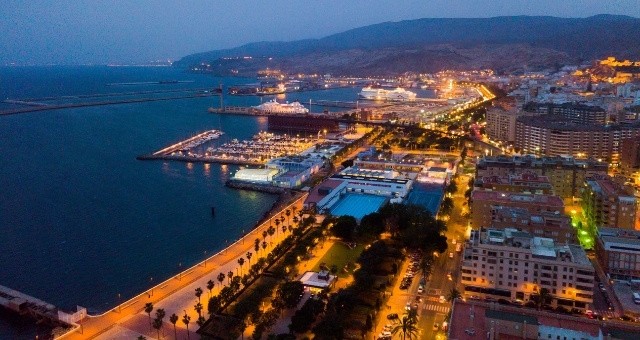
Evening lights at the bustling port and promenade of Almería
Book ferry tickets from Almería online
On Ferryhopper, you can book tickets from Almería to North Africa in just a few clicks. Find all the information you need about ferry schedules from the port of Almería, check our Map of ferries for available ferry crossings, compare ferry companies, and book tickets with no hidden fees!
Almería ferry schedule
View the complete ferry schedule from and to Almería for the upcoming week. Find up-to-date trip information, including departure and arrival dates and times, ferry operators and ticket prices.